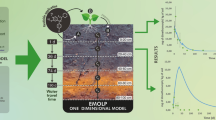Abstract
The movement and degradation of pesticide residues in soils and groundwater are complex processes affected by soil physical, (bio)chemical, and hydrogeological properties, climatic conditions, and agricultural practices. This work presents a physically-based analytical model suitable for long-term predictions of pesticide concentrations in groundwater. The primary interest is to investigate the impact of soil environment, related physical and (bio)chemical processes, especially, volatilization, crop uptake, and agricultural practices on long-term vulnerability of groundwater to contamination by pesticides. The soil is separated into root and intermediate vadose zones, each with uniform properties. Transport in each soil zone is modeled on the basis of complete mixing, by spatial averaging the related point multiphase-transport partial differential equation (i.e., linear-reservoir models). Transport in the aquifer, however, is modeled by a two-dimensional advection-dispersion transport equation, considering adsorption and first-order decay rate. Vaporization in the soil is accounted for by assuming liquid-vapor phase partitioning using Henry's law, and vapor flux (volatilization) from the soil surface is modeled by diffusion through an air boundary layer. Sorption of liquid-phase solutes by crops is described by a linear relationship which is valid for first-order (passive) crop uptake. The model is applied to five pesticides (atrazine, bromacil, chlordane, heptachlor, and lindane), and the potential for pesticide contamination of groundwater is investigated for sandy and clayey soils. Simulation results show that groundwater contamination can be substantially reduced for clayey soil environments, where bio(chemical) degradation and volatilization are most efficient as natural loss pathways for the pesticides. Also, uptake by cross can be a significant mechanism for attenuating exposure levels in ground-water especially in a sandy soil environment, and for relatively persisting pesticides. Further, simulations indicate that changing agricultural practices can have a profound effect on vulnerability of groundwater to mobile and relatively persisting pesticides.
Similar content being viewed by others
References
J. Bear,Hydraulics of Groundwater, American Elsevier, 1979.
W.H.J. Beltman, J.J.T.I. Boesten and S.E.A.T.M. Van der Zee, Analytical modelling of pesticide transport from the soil surface to a drinking water well. J. Hydrol. 169 (1995) 209–228.
J.J.T.I. Boesten and A.M.A. Van der Linden, Modeling the influence of sorption and transformation on pesticide leaching and persistence, J. Environ. Qual. 20 (1991) 425–435.
G.G. Briggs, R.H. Bromilow and A.A. Evans, Relationship between lipophilicity and root uptake and translocation of nonionised chemicals by barley, Pestic. Sci. 13 (1982) 495–504.
D.R. Cayan and B.C. Weare, Some aspects of recent climatic variability in Davis, California, Contributions in atmospheric science No. 14, University of California-Davis, 1977.
V.T. Chow, D.R. Maidment and L.W. Mays,Applied Hydrology, McGraw-Hill, 1988.
S.Z. Cohen, S.M. Creeger, R.F. Carsel and C.G. Enfield, Potential for pesticide contamination of groundwater resulting from agricultural uses, in:Treatment and Disposal of Pesticide Wastes, R.F. Kruger and J.N. Sieber (eds.), ACS Symposium Series No. 259, American Chemical Association, Washington, DC, 1984, pp. 297–325.
C.J. Duffy and L.W. Gelhar, A frequency domain approach to water quality modeling in groundwater: Theory, Water Resour. Res. 21 (1985) 1175–1184.
C.J. Duffy and D.-H. Lee, Base flow response from nonpoint source contamination: simulated spatial variability in source, structure, and initial condition, Water Resour. Res. 28 (1992) 905–914.
R.A. Feddes, P. Kowalik, K. Kolinska-Malinka and H. Zaradny, Simulation of field water uptake by plants using a soil water dependent root extraction function. J. Hydrol. 31 (1976) 13–26.
R.A. Freeze and J.A. Cherry,Groundwater, Prentice-Hall, 1979.
L.W. Gelhar and J.L. Wilson, Ground-water quality modeling, Ground Water 12 (1974) 399–408.
L.W. Gelhar and C.L. Axness, Three-dimensional stochastic analysis of macrodispersion in aquifers, Water Resour. Res. 19 (1983) 161–180.
W.A. Jury, W.F. Spencer and W.J. Farmer, Behavior assessment model for trace organics in soil: I. Model description. J. Environ. Qual. 12 (1983) 558–564.
W.A. Jury, W.J. Farmer and W.F. Spencer, Behavior assessment model for trace organics in soil: II. Chemical classification and parameter sensitivity. J. Environ. Qual. 13 (1984) 567–572.
W.A. Jury, D.D. Focht and W.J. Farmer, Evaluation of pesticide groundwater pollution potential from standard indices of soil-chemical adsorption and biodegradation. J. Environ. Qual. 16 (1987) 422–428.
W.A. Jury and J. Gruber, A stochastic analysis of the influence of soil and climatic variability on the estimate of pesticide groundwater pollution potential, Water Resour. Res. 25 (1989) 2465–2474.
W.A. Jury,Soil Physics, Wiley, 1991.
W.O. Pruitt and R.L. Snyder, Reference evapotranspiration (Eto) for California, Agricultural Experiment Station, University of California, Division of Agriculture and Natural Resources, Bulletin 1922, 1987.
P.S.C. Rao, A.G. Hornsby and R.E. Jessup, Indices for ranking the potential for pesticide contamination of groundwater. Proc. Soil Crop Sci. Soc. Fla 44 (1985) 1–8.
W.F. Spencer and M.M. Cliath, Desorption of lindane from soil as related to vapor density, Soil Sci. Soc. Am. Proc. 34 (1970) 574–578.
S.E.A.T.M. Van der Zee and J.J.T.I. Boesten, Effects of soil heterogeneity on pesticide leaching to groundwater, Water Resour. Res. 27 (1991) 3051–3063.
P. Varshney, U.S. Tim and C.E. Anderson, Risk-based evaluation of ground-water contamination by agricultural pesticides, Ground Water 31 (1993) 356–362.
Author information
Authors and Affiliations
Rights and permissions
About this article
Cite this article
Hantush, M.M., Mariño, M.A. An analytical model for the assessment of pesticide exposure levels in soils and groundwater. Environ Model Assess 1, 263–276 (1996). https://doi.org/10.1007/BF01872154
Received:
Revised:
Issue Date:
DOI: https://doi.org/10.1007/BF01872154




